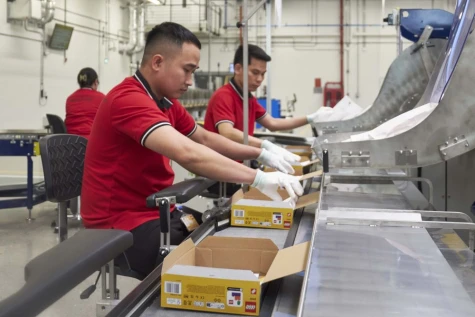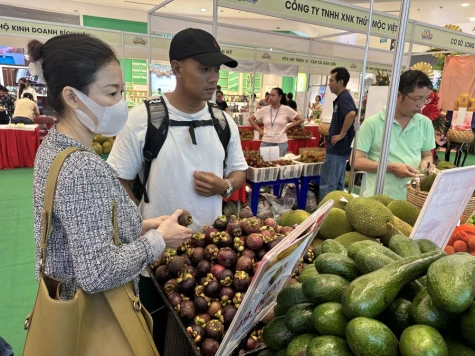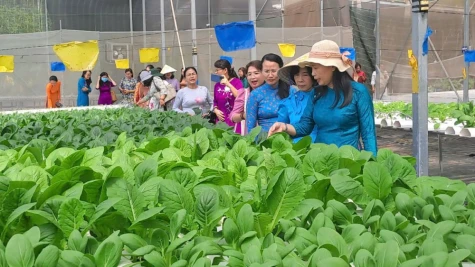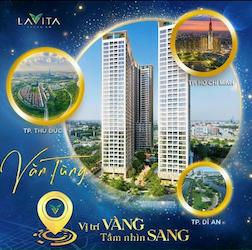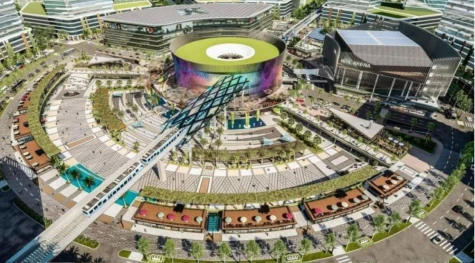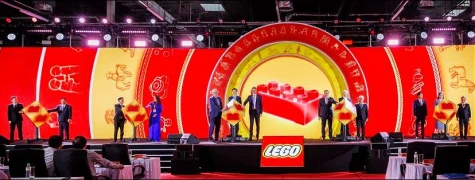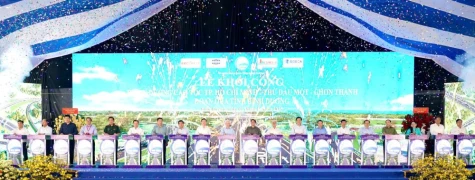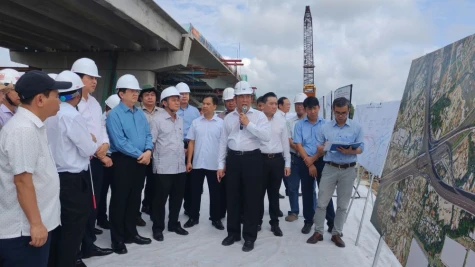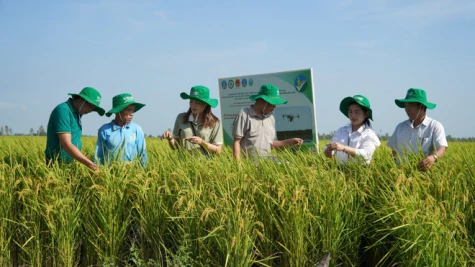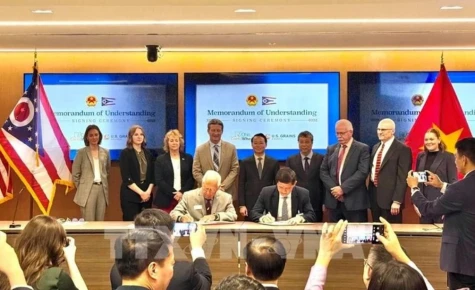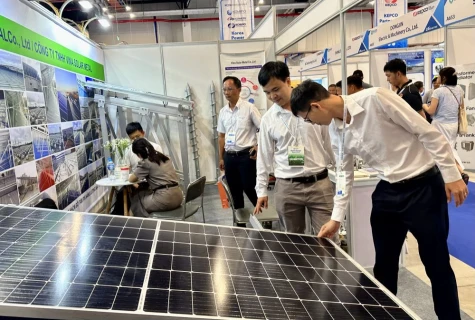Fifty years after the South's complete liberation and nearly thirty years of construction and development, with various models implemented throughout each stage, Binh Duong acknowledged that the local decision to focus on the development of concentrated industrial parks (IPs) was a creative and wise strategic choice. These Ips have helped transform Binh Duong from an “unknown” province on the national economic map into a dynamic industrial-urban locality, becoming one of the exemplary models in Vietnam's renovation process.
Achievements of development
Once a fierce battlefield, the “Iron Triangle” region of Ben Cat has now taken on a completely new look – a youthful, dynamic city and one of the province's industrial-urban-service hubs. This transformation was made possible through Ben Cat’s strategic focus on building IPs as a breakthrough factor for industrial development.

Nguyen Trong An, Vice Secretary of Ben Cat city’s Party Committee and Chairman of the city’s People's Committee stated that the city's economy only began to truly flourish after provincial Party Committee implemented a policy on relocating industries to districts in the northern region of the province. Today, Ben Cat city is home to My Phuoc 1, 2, 3, 4, Thoi Hoa, Protrade, Viet Huong 2, Rach Bap Ips and other Ips. These IPs have attracted over US$ 8 billion in foreign direct investment. They have enabled Ben Cat to rapidly shift from an agriculture-based economy to an industrial one while also spurring urban, commercial and service development, thereby improving living standards and business conditions for local residents.
Not only being implemented in Ben Cat, provincial policy on moving industrial development northward has proven its effectiveness, helping other localities grow rapidly. Numerous large, modern industrial parks and compounds are being planned and built in North Tan Uyen, Phu Giao, Bau Bang and Dau Tieng districts, significantly transforming their urban images.
According to Dr. Huynh Ngoc Dang, President of provincial Historical Science Association, Binh Duong has witnessed the evolution of several generations of IPs. Particularly, traditional IPs emerged in 1997, followed by integrated industrial-urban-service zones in 2002 and most recently, in 2022, the province began transitioning to model green Ips aimed at fostering the science and technology-based ones. To ensure sustainable industrial growth, Binh Duong has launched the "Innovation Region" project, which includes the construction of a science and technology IP in Bau Bang. In this new phase, Binh Duong is positioning itself to develop industry in parallel with science, technology and innovation. “Thus, it was Binh Duong’s model of IPs that laid the foundation for new generations of IPs”, Dr. Dang emphasized.
Today, Binh Duong’s image has truly transformed. Surrounding the local Ips is a comprehensive urban ecosystem that caters to the needs of the local workforce and residents. From an agriculture-based province, Binh Duong has transformed dramatically, with over 84% of its population now living in urban areas — one of the highest urbanization rates in the country. Notably, the Vietnam - Singapore Industrial Park (VSIP) model, which originated in Binh Duong nearly 30 years ago, has since expanded across the nation, leaving its mark in all three regions: North, Central and South. VSIP has become a model for centralized IP development domestically and internationally. The effectiveness and far-reaching influence of the VSIP brand serve as a vivid testament to a dynamic, innovative and globally integrated Binh Duong-a province committed to sustainable development.
Confidence on the path of development
Currently, IPs in Binh Duong have an average occupancy rate of nearly 94%, positioning the province as one of the country's leading localities in attracting investment into IPs. Many IPs have now become well-recognized brands, enabling Binh Duong to attract major enterprises and multinational corporations to invest in the province. However, in order to maintain its appeal to investors in the future, Binh Duong plans to upgrade existing IPs to become smarter while also planning the new ones that are modern and eco-friendly.
Nguyen Trung Tin, Head of provincial IPs Management Board shared that in response to the new context, Binh Duong is developing IPs with a more specialized focus to attract higher quality and more effective investment projects. Binh Duong will focus on developing new IPs in the direction of ecological, high-tech and specialized industries. Therefore, for newly established IPs, in addition to the multi-sector model, priority will be given to the development of auxiliary, specialized, eco and high-tech IPs.
From now until 2030, Binh Duong plans to invest in 10 new IPs. In 2025, two IPs in North Tan Uyen district and Tan Uyen city will be developed, covering a total area of 1,000 hectares. The remaining eight IPs, with a combined area of over 6,000 hectares, will be developed in North Tan Uyen, Dau Tieng and Phu Giao by the end of 2030. With its experience in IP infrastructure and sustainable industrial development, Binh Duong is now restructuring its industrial space. Accordingly, IPs will be developed in connection with traffic belts to facilitate logistics and regional connectivity, thus driving economic development not only for Binh Duong, but also for the entire Southeastern region.
Professor Dr. Ta Ngoc Tan, Permanent Vice Chairman of the Central Theoretical Council affirmed that with its innovative approach, Binh Duong has emerged as a national leader in IP development and an attractive destination for investors. The success of these IPs is contributing to the formation of a dynamic and prosperous Binh Duong. In the coming time, Binh Duong needs to continue determining that industrialization and modernization must be based on the foundation of science and technology, innovation and make good use of the opportunities of the 4th industrial revolution to make a breakthrough and rise up.
Vo Van Minh, Vice Secretary of provincial Party Committee and Chairman of provincial People's Committee emphasized that the success of IPs is key to Binh Duong’s dynamic development. Along with accelerating infrastructure development and taking bold steps to improve the investment environment, facilitating business operations and attracting domestic and foreign capital flows, Binh Duong has continued identifying industry as the key pillar of the local economy. The province has consistently viewed IP development as a means to drive socio-economic progress for people and the nation. Binh Duong is also proactively preparing favorable conditions such as clean land reserves, planned IPs, a supportive technology ecosystem, workforce training programs and the development of social and worker housing. These efforts aim at ensuring timely and sufficient labor supply for enterprises investing in the province.
In 1995, Binh Duong's industrial policy made a breakthrough with the establishment of the Song Than Industrial Park. Since then, industrial development has been the province's breakthrough focus, consistently pursued throughout various periods. Binh Duong has prioritized the development of concentrated IPs, creating an open environment to attract domestic and foreign investment, fostering in-depth construction and development and laying the foundation for the stability and sustainability of the local economy.
The strategy to build IZs as a driving force for development has reflected Binh Duong’s timely and visionary mindset. The emergence of these IZs has spurred the province’s industrial growth and laid the foundation for trade, services and urban development. Featuring synchronized, modern infrastructure and prime locations near major transportation routes connected to Ho Chi Minh City and surrounding areas, Binh Duong’s Ips have attracted major corporations and multinational investors.
Reported by Ngoc Thanh-Thanh Tuyen-Translated by Kim Tin








